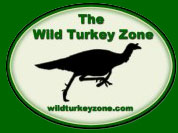|
Double Talk for Tough Gobblers
By Mark Koehler
As hunting pressure increases, gobblers often become
wise and call shy. When I think that the gobbler that
I have set up has been called to before and normal
calling methods are not working, then it is time to
change tactics. One choice might be the use of two
calls to simulate hen talk. I often relocate and try
to sound like two or more hens feeding. I do not call
to the gobbler until he shows interest.
 One
example took place during the second week of the Missouri
spring season. A heavy sounding gobbler had set up
camp in a heavily wooded area with dirt roads on the
north and east side. Several hunters had tried to
call him as he would answer shock calls from the road.
All they had succeeded in doing was educating him.
I decided it was my turn when I heard him gobble while
I was feeding cows. One
example took place during the second week of the Missouri
spring season. A heavy sounding gobbler had set up
camp in a heavily wooded area with dirt roads on the
north and east side. Several hunters had tried to
call him as he would answer shock calls from the road.
All they had succeeded in doing was educating him.
I decided it was my turn when I heard him gobble while
I was feeding cows.
It was around 9:30 a.m. when I eased into the woods
and set up. I called softly and he immediately answered
and started to work my way. I continued to call and
purr. He was interested but would not get any closer
that about 75 yards. Finally, he shut up completely
and when he did gobble again he was further away.
The normal approach had not worked so it was time
to change tactics. So I called real aggressively and
shut up. Then I headed to the other side of the wooded
area. I knew that he would stay away from the road
so all that I had to do was get to the other side
with out being seen. This meant about a mile hike.
As I was moving to the other side he would gobble
about every 10 minutes.
When I got around him I set up behind a huge black
oak and waited for him to gobble then I called real
soft using a double reed call with my mouth close
to the back side of the tree. I did this hoping that
he would not be able to pinpoint my location. After
using the twin call I switched to a triple and called
slightly louder then back to the twin. I was not calling
to the gobbler but I was making hen talk.
I had no more than got the third call out when he
gobbled from about 200 yards, I called again and he
double-gobbled, I continued to hen talk using two
calls until he was about 100 yards from me. He was
getting fired up so I didn’t change calls. Using
the twin, I continued to call with my mouth close
to the back side of the tree, and scratched in the
leaves. He came charging in double and triple gobbling.
I had to let him get past me slightly since I was
behind the tree before I could shoot. I dropped him
with one shot at 17 steps. He weighed 21 pounds with
a 11 ½ inch beard and 1 ¼ inch spurs.
Patience and double talk had helped me take my second
gobbler for the spring. The time was 11:30 a.m.
(You can contact Mark at diamondkoutfitters@hotmail.com
)
|

